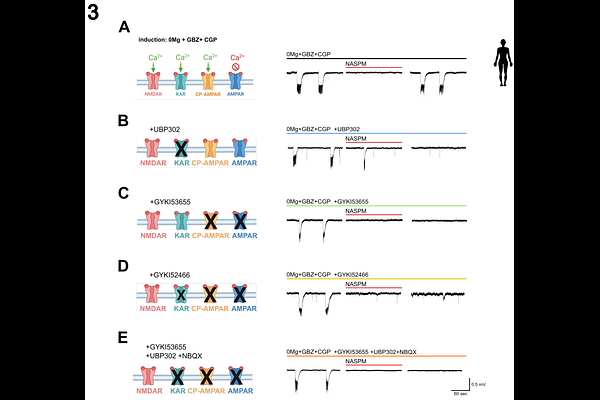The polyamine naphthyl-acetyl spermine trihydrochloride (NASPM) lacks specificity for Ca2+-permeable AMPA receptors and suppresses seizure like activity in human brain tissue by inhibition of NMDA receptors.

The polyamine naphthyl-acetyl spermine trihydrochloride (NASPM) lacks specificity for Ca2+-permeable AMPA receptors and suppresses seizure like activity in human brain tissue by inhibition of NMDA receptors.
Podesta, A.; Monni, L.; Arnold, F. L.; Arnold, J.; Bertelli, S.; xu, R.; Onken, J.; Thomale, U.-W.; Kalbhenn, T.; Simon, M.; Sauvigny, T.; Alle, H.; Plested, A. J.; Holtkamp, M.; Geiger, J. R.; Fidzinski, P.
AbstractFor decades, naphthyl-acetyl spermine trihydrochloride (NASPM) has been used as a selective inhibitor of calcium-permeable AMPA receptors (CP-AMPAR). In rodents, NASPM is known to suppress seizures in vivo and seizure-like events (SLE) in vitro, suggesting possible involvement of CP-AMPAR in ictogenesis and epileptogenesis. To address whether these findings can be translated to human brain, we investigated the involvement of glutamatergic receptor subclasses in SLE in human cortex ex vivo, demonstrating that glutamatergic receptor antagonists can block (NASPM and APV) or reduce (UBP302, GYKI52466, GYKI53655) SLE. Using a multimethodological approach we were able to demonstrate that both NASPM and APV inhibit human SLE by inhibition of NMDA receptors. Our results further show that the inhibitory effect of NASPM on NMDA receptors is sufficient to explain its inhibition of seizure like activity, rather than its action on CP-AMPA receptors. Thus, our findings challenge previous knowledge on the use of NASPM as a specific CP-AMPAR inhibitor. Some phenomena previously attributed to CP-AMPAR, may need to be re-examined more closely. Overall, our study raises awareness about potential pitfalls in the use of existing pharmacological agents and sets a new paradigm for the use of NASPM in neuroscience research while questioning its therapeutic potential in a clinical context.